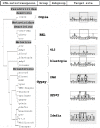Mechanisms of LTR-Retroelement Transposition: Lessons from Drosophila melanogaster
- PMID: 28420154
- PMCID: PMC5408687
- DOI: 10.3390/v9040081
Mechanisms of LTR-Retroelement Transposition: Lessons from Drosophila melanogaster
Abstract
Long terminal repeat (LTR) retrotransposons occupy a special place among all mobile genetic element families. The structure of LTR retrotransposons that have three open reading frames is identical to DNA forms of retroviruses that are integrated into the host genome. Several lines of evidence suggest that LTR retrotransposons share a common ancestry with retroviruses and thus are highly relevant to understanding mechanisms of transposition. Drosophila melanogaster is an exceptionally convenient model for studying the mechanisms of retrotransposon movement because many such elements in its genome are transpositionally active. Moreover, two LTRretrotransposons of D. melanogaster, gypsy and ZAM, have been found to have infectious properties and have been classified as errantiviruses. Despite numerous studies focusing on retroviral integration process, there is still no clear understanding of integration specificity in a target site. Most LTR retrotransposons non-specifically integrate into a target site. Site-specificity of integration at vertebrate retroviruses is rather relative. At the same time, sequence-specific integration is the exclusive property of errantiviruses and their derivatives with two open reading frames. The possible basis for the errantivirus integration specificity is discussed in the present review.
Keywords: Drosophila; LTR‐retrotransposon; errantivirus; retrovirus; transposition.
Conflict of interest statement
The authors declare no conflict of interest. The founding sponsors had no role in the design of the study; in the collection, analyses, or interpretation of data; in the writing of the manuscript, and in the decision to publish the results.
Figures





Similar articles
-
Integration specificity of LTR-retrotransposons and retroviruses in the Drosophila melanogaster genome.Virus Genes. 2011 Apr;42(2):297-306. doi: 10.1007/s11262-010-0566-4. Epub 2011 Jan 8. Virus Genes. 2011. PMID: 21369828
-
[Precise excision of long terminal repeats of the gypsy (mdg4) retrotransposon of Drosophila melanogaster detected in Escherichia coli cells is explained by its integrase function].Genetika. 2006 Dec;42(12):1656-63. Genetika. 2006. PMID: 17326385 Russian.
-
[Evolution from retrotransposons to retroviruses: origin of the env gene].Zh Obshch Biol. 2007 Nov-Dec;68(6):459-67. Zh Obshch Biol. 2007. PMID: 18257289 Russian.
-
Transposable elements: how non-LTR retrotransposons do it.Curr Biol. 1997 Apr 1;7(4):R245-8. doi: 10.1016/s0960-9822(06)00112-6. Curr Biol. 1997. PMID: 9162502 Review.
-
The role of LTR retrotransposons in plant genetic engineering: how to control their transposition in the genome.Plant Cell Rep. 2023 Jan;42(1):3-15. doi: 10.1007/s00299-022-02945-z. Epub 2022 Nov 19. Plant Cell Rep. 2023. PMID: 36401648 Review.
Cited by
-
Correlation in Expression between LTR Retrotransposons and Potential Host Cis-Targets during Infection of Antherea pernyi with ApNPV Baculovirus.Viruses. 2019 May 6;11(5):421. doi: 10.3390/v11050421. Viruses. 2019. PMID: 31064084 Free PMC article.
-
Proteomics technique opens new frontiers in mobilome research.Mob Genet Elements. 2017 Aug 1;7(4):1-9. doi: 10.1080/2159256X.2017.1362494. eCollection 2017. Mob Genet Elements. 2017. PMID: 28932623 Free PMC article.
-
Retrovirus-like Gag Protein Arc1 Binds RNA and Traffics across Synaptic Boutons.Cell. 2018 Jan 11;172(1-2):262-274.e11. doi: 10.1016/j.cell.2017.12.022. Cell. 2018. PMID: 29328915 Free PMC article.
-
Diversification and collapse of a telomere elongation mechanism.Genome Res. 2019 Jun;29(6):920-931. doi: 10.1101/gr.245001.118. Epub 2019 May 28. Genome Res. 2019. PMID: 31138619 Free PMC article.
-
Long-read sequencing of the zebrafish genome reorganizes genomic architecture.BMC Genomics. 2022 Feb 10;23(1):116. doi: 10.1186/s12864-022-08349-3. BMC Genomics. 2022. PMID: 35144548 Free PMC article.
References
Publication types
MeSH terms
Substances
LinkOut - more resources
Full Text Sources
Other Literature Sources
Molecular Biology Databases

